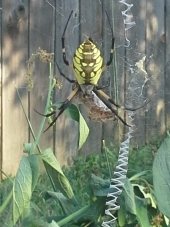








Pecan Media: food forestry and forest garden ebooks
Now available: The Native Persimmon (centennial edition)




"We're all just walking each other home." -Ram Dass
"Be a lamp, or a lifeboat, or a ladder."-Rumi
"It's all one song!" -Neil Young




Dan Boone wrote:I had an outbreak of blister beetles last year on my yellow pear tomatoes that was greatly diminished after several praying mantises showed up. I didn't witness them hunting the blister beetles, so coincidence is a possible explanation,
Judith Browning wrote:Striped or black?
We have only had the striped ones twice in the forty years we've gardened in arkansas. they came by the thousands to many in this county the same week a couple summers ago....very dry and hot weather. I panicked and tried all kinds of things......from pans of soapy water to a shop vac and really nothing made a dent in them. They came, they ate, and they left on their own time...with in a week. They ate all but the purple tomatoes vines, most of the peppers and hid in but did not eat the sweet potato vines....I can't remember anything else that they did or didn't eat....but it wasn't everything or even all of anything. I was able to replant much of it.
The black ones are worse though, I think...once you notice them they never seem to leave and spread from plant to plant...we don't have them very often but try to always watch for those first ones and kill them. I use my bare hands to knock them into soapy water but have also squished and never been 'blistered'. If we are able to catch them early though they aren't a problem.
I thought the guineas that we had briefly were eating squash/stink bugs for sure and wondered if they might eat blister beetles, but we had none to test them with. We liked having guineas in the garden once the plants were big enough to be walked on and around, they don't scratch or go for fruit like chickens do.








Jay C. White Cloud wrote: A "trap crop" if coordinated with known times of the beatles appearance can be very effective in depleting the population before hand. Pigweed (Amaranthus sp) has worked for this.
Jay C. White Cloud wrote:Diatomaceous earth was also very effective in reducing their numbers when properly applied.









Have you had your minimum daily fiber allowance? If not, visit UrsulasYarn.etsy.com for natural fibers including: wool, hemp, linen, and more. Natural dyes are season dependent.
 5
5




 1
1





 2
2




Failure is a sign of activity and learning. It had nothing to do with under achievement
I never want to have a team member who has never failed - They are not doing!! 👍
 1
1




If there is one thing the Wizard of Oz has taught me, it is not to trust school teachers on bicycles.
 3
3




 2
2




 Grandma says, when you make it fun, we'll get more done!
Grandma says, when you make it fun, we'll get more done!

|
I can't beleive you just said that. Now I need to calm down with this tiny ad:
The new permaculture playing cards kickstarter is now live!
https://www.kickstarter.com/projects/paulwheaton/garden-cards
|





